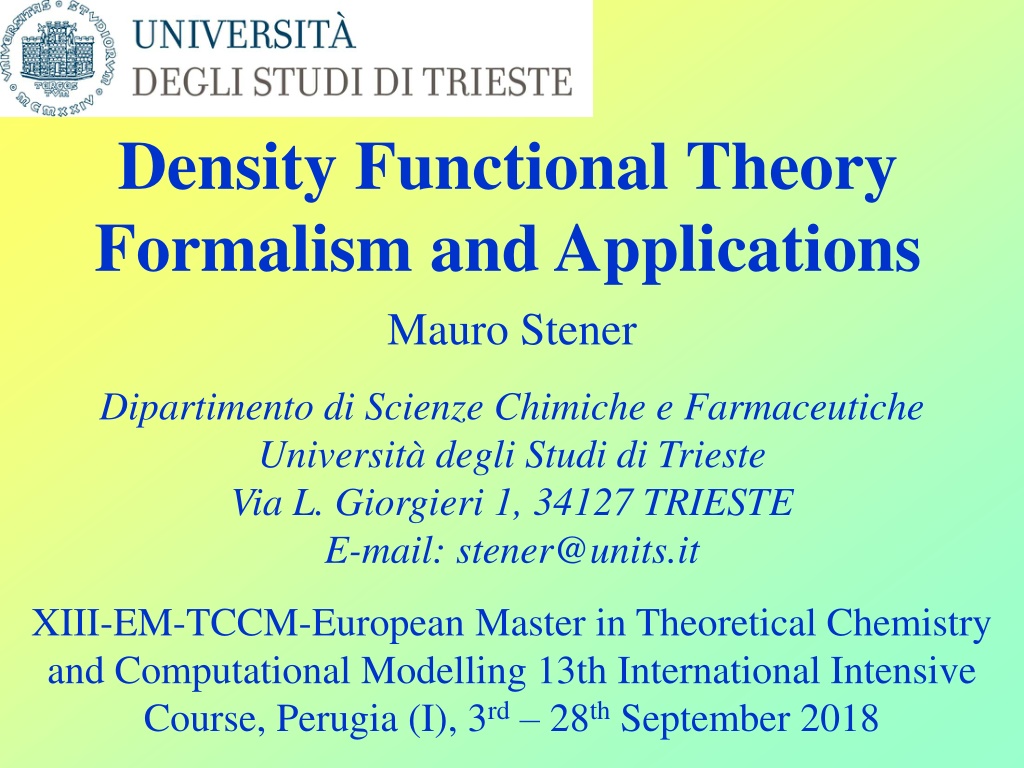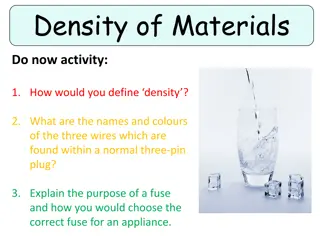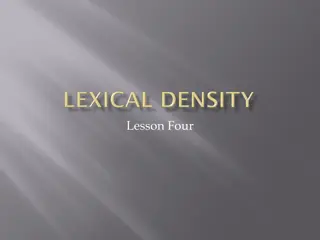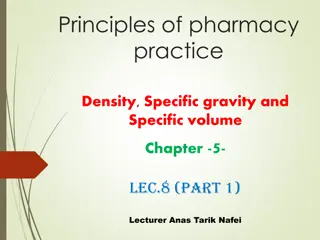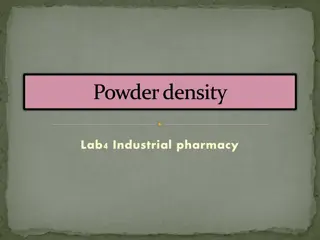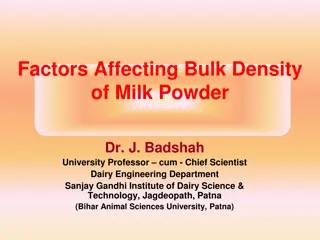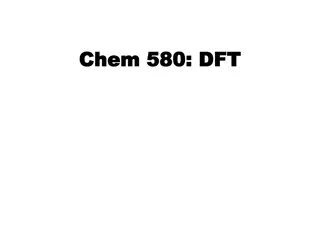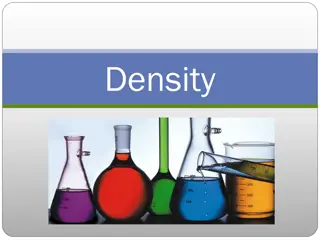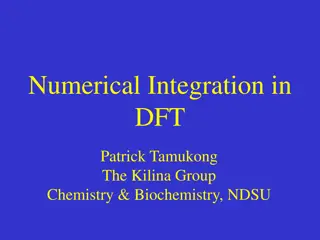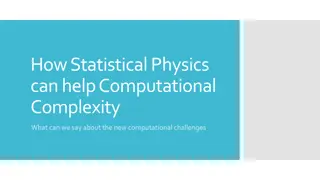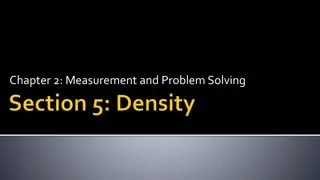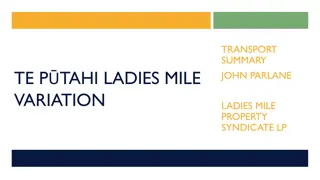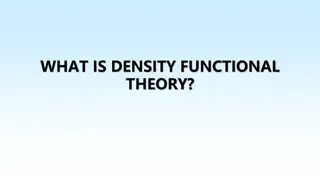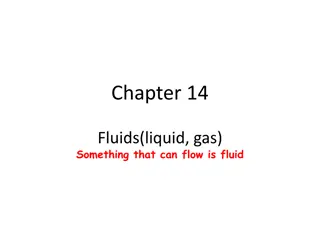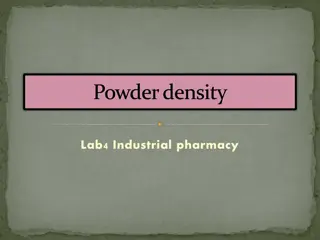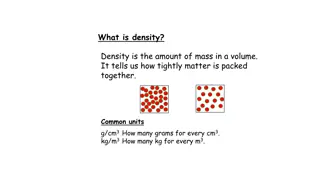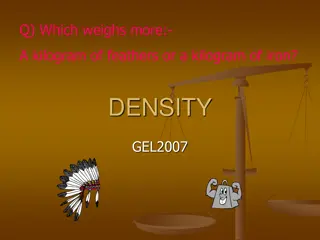Understanding Density Functional Theory in Computational Chemistry
Dive into the formalism and applications of Density Functional Theory (DFT) through a comprehensive review of basic theory, equations, and numerical implementations. Explore concepts like Time-Dependent DFT (TDDFT) and Linear Response formalism, and discover its applications in studying plasmons, core electron excitations, and more. Uncover the Linear Response Hamiltonian in TDDFT and learn about small perturbations, induced properties, and convergence factors in this advanced theoretical chemistry field.
Download Presentation

Please find below an Image/Link to download the presentation.
The content on the website is provided AS IS for your information and personal use only. It may not be sold, licensed, or shared on other websites without obtaining consent from the author. Download presentation by click this link. If you encounter any issues during the download, it is possible that the publisher has removed the file from their server.
E N D
Presentation Transcript
Density Functional Theory Formalism and Applications Mauro Stener Dipartimento di Scienze Chimiche e Farmaceutiche Universit degli Studi di Trieste Via L. Giorgieri 1, 34127 TRIESTE E-mail: stener@units.it XIII-EM-TCCM-European Master in Theoretical Chemistry and Computational Modelling 13th International Intensive Course, Perugia (I), 3rd 28thSeptember 2018
Summary 1. THEORY - DFT Review of DFT basic theory and equations 2. THEORY - TDDFT with the aim to underline what is general from Linear Response formalism. 3. COMPUTATIONAL - Some numerical aspects of the implementation in the ADF code, most important computational choices, how to assign spectral features. New TDDFT algorithm. 4. APPLICATIONS: 4.a. Plasmons in metal clusters. 4.b. Core electron excitations (NEXAFS).
TDDFT: Linear Response (LR) Excited states are beyond KS theory! A time dependent perturbation H(1)generates an induced density (1)and therefore an induced dipole: ( ) ) t V t , , r E = ( )( ) t , 1r ( )( 1r ( ) r It is more convenient to work with FT in frequency domain: ( )( ( )( ) = ( )( ( )( ) e ( )( ( )( ) e = , ) , + + 1 1 1 i t i t r r r , , H t ) V e V e ) 1 1 1 i t i t r r r , , t
TDDFT: Linear Response (LR) Hamiltonian: small TD perturbation: = + 0 (1) ( ) ( ) t H t H H V ( )( ) ( )( ) ( )( ) = + 1 1 1 i t i t r r r , , , exp( ) H t e V e t Convergence factor with >0: e t 0 when t - while e t 1 for finite t: in this way the perturbation is switched on adiabatically = i i exp( ) exp( ( )) t t V ( )( ) ( )( ) ( )( ) + = + 1 1 ( ) 1 ( ) i i t i i t r r r , , , H t e V e The convergence factor can be considered as a small imaginary frequency.
TDDFT: Linear Response (LR) Hamiltonian: small TD perturbation: = + 0 (1) ( ) ( ) t H t H H = ) 0 ( ) 0 ( n ) 0 ( n ) 0 ( n H E Assume to know all solutions of H(0): ( ) ( ) n = + ) 0 ( 0 ) 0 ( 0 ) 0 ( n ) 0 ( n exp ( ) exp iE t c t iE t = Solve with: H i n t 0 ( ) i exp i t ( ) = En ) 0 ( ) 0 ( 0 E = , ) 1 ( r 0 ( ) 0 n c t n V After some algebra : 0n n i 0 n From coefficients, all the induced properties (i.e. electric dipole =er) can be obtained: = ) 1 ( ) 0 ( 0 ) 0 ( 0
TDDFT: Linear Response (LR) From coefficients, all the induced properties (i.e. electric dipole =er) can be obtained: ( ) ( ) ( ) ( ) = + ) 1 ( ) 1 ( ) 1 ( r r , , exp( ) , , exp( ) V i t V i t ( ) ( ) , , ) 0 ( 0 ) 0 ( ) 0 ( ) 1 ( ) 0 ( 0 ) 0 ( 0 ) 1 ( ) 0 ( ) 0 ( ) 0 ( 0 r r V + V ( ) ( ) n n + n n , = ) 1 ( r , V i + + i 0 n 0 0 n n Dynamical polarizability = pq( ) p,q=x,y,z What happens on a resonance? 0n 2 ) 0 ( ) 0 ( 0 ) ( becomes imaginary and proportional to the transition moment! z 2 ( ) n = = ) 0 ( 0 ) 0 ( i z 0 zz n n i displays poles at excitation energies, the residues correspond to the transition moment or oscillator strength (f)
TDDFT: Linear Response (LR) In general, the density (1)induced by an external TD perturbative field V(1)is: ( ) ( ) V ( ) = ) 1 ( ) 1 ( r r r , ' r r , , , ' ' d Where is the dielectric susceptibility of the interacting system, not easily accessible 1. LR (general): R. McWeeny, Methods of molecular quantum mechanics , Second Edition, Academic Press, London 1989 2. LR-TDDFT: M. E. Casida, in Recent Advances in Density Functional Theory , World Scientific, Singapore 1995 p. 155. 3. TDHF: A. D. McLachlan and M. A. Ball, Rev. Mod. Phys. 36 (1964) 844
TDDFT justifies the use of the KSof the non-interacting system: ( ) ( , , r Provided: ( ' r r ) VSCF ( ) ) 1 ( = ) 1 ( KS r r , ' r r , ' ' d ) ) 1 ( , ' r ( ) ( ) ( ) ( ) ) 1 ( ) 1 ( = + + ) 1 ( r r r r r , ' r r , , ' , , ' ' V V d f d SCF XC Runge Gross theorem: PRL 52 (1984) 997 fXC(XC kernel) is unknown, approximated by Adiabatic LDA: ( , , r f XC ( ( ) r ( ) r ) LDA XC ' dV ) ( ) ' r = r r ' d ' KSis easy to calculate:
KSis expressed in terms of KS orbitals and energies: ( ) ( ) ( ) ( ) ( a ( ) ( ) ( ) ( ) ( a * * * * occ unocc occ unocc r r r r r r r r ( ) i i , = + KS , i a a i i a a i i r r ) ) + i a a i i This expression can easily be obtained from the dynamical polarizability, using a KS zero order: ( ) ( ) , , ) 0 ( 0 ) 0 ( ) 0 ( ) 1 ( ) 0 ( 0 ) 0 ( 0 ) 1 ( ) 0 ( ) 0 ( ) 0 ( 0 r r V + V ( ) ( ) n n + n n , = ) 1 ( r , V i + + i 0 n 0 0 n n ( , r ) = = ) 0 ( ) 1 ( ) 0 ( 0 a i KS V z z n a i
Therefore, dynamic polarizability xz() can be rigorously calculated at TDDFT level: ( ) xz ( )( z ) 1 = , r r xd The mean dynamic polarizability ( ) is related to excitation energies EIand oscillator strengths fI : 1 f ( ) ( ) = = I trace 2 2 3 E I I ( ) has poles at EI and the residues are connected to the fI
Recast basic equations, in order to implement, density matrix formulation according to Casida Express (1)in terms of KS orbitals: Occupied orthonormal KS orbitals: = , i j i j I order variation: + = =0 0 d d d d i j i j i j i j VIRT a = a i d c i a
TD behaviour of KS orbitals and their perturbations: ( ) ( ) r = i t r, t e i i i The perturbed KS orbitals have two terms because the TD perturbation has two terms: e-i tand ei t: ( ) ( ) r ( ) r ( ) ( )t + + = + i t i ) 1 ( , 1 ( ) , 1 ( ) r , t e e i i i i i Now both terms are expanded as linear combinations of virtual orbitals: VIRT VIRT ( ) ( ) + = X = Y , 1 ( ) , 1 ( ) * r r i ia a i ia a a a
TD behaviour of the induced density: occ i = i * i occ ( )( ) ( ) ( ) ( ) ( ) i = + 1 ) 1 ( * 1 ( )* r r r r r , , , , , t t t t t i i i i ( ) ( ) occ ( )( ) ( ) ( ) r ( ) ( ) r ( ) ( ) r ( ) ( ) r i + + = + + + 1 , 1 ( ) * , 1 ( )* , 1 ( )* , 1 ( ) * i t i t r r r r r , t e e i i i i i i i i Complex conjugate ( )( ) ( )( ) ( )( ) = , + 1 1 1 i t i t r r r , , t e e ( ) OCC VIRT ( )( ) i = + i 1 * * r , X Y a i ia a ia a
Express (1)in terms of the density matrix P over occupied and virtual KS orbitals ( ) ( ) VSCF ( ) ) 1 ( = ij ) 1 ( KS r r r , ' r r , , , ' ' d = KS SCF kl V P ij ij , kl jb jb = + KS ia SCF jb KS ia SCF bj V X V , , ia jb bj jb jb = + KS ai SCF jb KS ai SCF bj V Y V , , ia jb bj
With the occupied-virtual representation, susceptibility matrix has a very simple diagonal form: Occupation numbers n n j i = k l KS ( ) ij , , , , kl i j i j ) 1 ( = SCF ij V V i SCF j
Also the SCF potential may be expressed in terms of density matrix: ( ) ) 1 ( r , ' r ( ) ( ) ( ) ( ) ) 1 ( ) 1 ( = + + ) 1 ( r r r r r , ' r r , , ' , , ' ' V V d f d SCF XC r ' kl = + SCF ij V EXT ij V K P , ij kl kl 1 ( ) r ( ) r ( ) ( ) r k ( ) ' r l = xc + r r r , ' r ' , ' K d d f ij i j , kl r r '
Finally, two linear equations are coupled, solved with respect to P: = KS SCF P V = + SCF EXT V V KP ( ) ( ) 1 + = KS EXT K P V
Developing in matrix: A B 1 0 X V Forced oscillations = B A 0 1 Y V A B 1 0 X V Free = oscillations B A 0 1 Y V Eigenvalues Eigenvectors Free oscillations: Random Phase Approximation (RPA)-like equations, collective motion of electronic degrees of freedom, electron normal modes, plasmonic effect should be included!
Representation of matrices A and B Since KS is diagonal its inversion is trivial: ( ) = j b + A K , a i , , , , ia jb i a ia jb = B K , , ia jb ia bj Notice that A-B is diagonal: ( ) ( ) = j b = A B , a i , , , , i a ia jb ia jb
Resolution of the RPA-like equation A B X 1 0 X = B A Y 0 1 Y ( ( )( )( ) ) ( ( ) ) + + = A B X Y X Y = + A B X Y X Y ( ) ( ) ( ) 1 = + X Y A B X Y ( )( ) ( ) 1 + + = + 2 A B X Y X Y
( )( ) ( ) 1 + ) + ( = + 2 A B X Y X Y ( X ) ( ) 1 1 1 1 + + = + 2 A B X Y Y 2 2 2 2 F F 2 = F E F I I I
Density-matrix formulation the TDDFT equations: 2 = F E F I I I ( ) 2 = + 2 ( ) ( ) K , , ia jb ij ab a i a i ia jb b j 1 ( ) r ( ) r ( ) ( r ) ( ) r k ( ) ' r l ALDA xc = + r r r r ' ' ' K d d f ij i j , kl r r ' Input: molecular orbitals and orbital energies Output: discrete excitation spectrum (energies and intensity)
Oscillator strengths are extracted from eigenvectors: 2 2 2 2 + + + 1 2 1 2 1 2 = + + x S F y S F z S F If I I I 3 = x x i j ij k n , , , i l j = S ij ( )( ) , kl n l k k l
Separation between Singlet and Triplet If we consider the excitation of a Closed Shell (Singlet): a a This is not a spin eigenfunction: singlet and triplet are linear combinations of two determinants. i i i i = a i a i ( ) ( ) 1 1 = = + T a i i a S a i i a 2 2 The unitary transformation U transform the matrix in block diagonal form, with singlet and triplet blocks: 1 1 2 0 The Singlet and Triplet are solved separately. Triplet is dipole forbidden, only excitation energies are obtained since f=0. 1 1 S 1 0 = + = U U U T
Charge Transfer (CT) excitations, TDDFT shortcoming When i and a are localized in different regions of a molecule separated by distance R, the transition corresponds to a CT: e- R a i 1 ( ) r )2 i ( ) r ( ) ( r ) ( ) r ( ) r = ( = + = In TDDFT, ALDA: ALDA xc r r r r ' ' ' ' 0 K d d f i a i a , ia ia r = r ' I E Wrong result!!! , ia ia a a i In RPA, or TDDFT with non-local XC kernel: 1 ( ) = + = A ai ia ai ai Fine!!! , ia ia a i a i a i R Error in a: Electron Affinity in HF, in DFT not: the local potential is the same for all orbitals but is optimized for the occupied ones!
Comments: 1. Other competitive formulations: a) density instead of density matrix b) time domain over a cartesian grid (OCTOPUS) 2. Present density matrix formulation: allows detailed analysis and assignment of excited states via FI eigenvectors, useful! 3. Present density matrix formulation: large matrix diagonalization, computational demanding! 4. Outlook: formulate new algorithm which avoids diagonalization but allows assignment!
